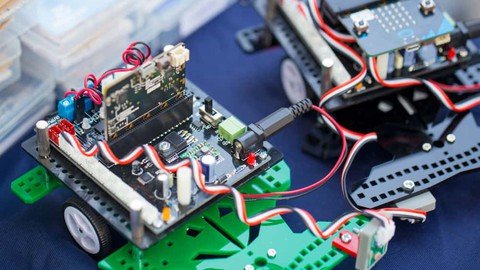
Free Download Introducing Embedded Systems And Microcontrollers
Published 4/2023
MP4 | Video: h264, 1280x720 | Audio: AAC, 44.1 KHz
Language: English | Size: 260.16 MB | Duration: 0h 31m
Getting Started with Embedded Systems and Microcontrollers: A Beginner's Guide
Free Download What you'll learn
The fundamentals of embedded systems, including their design, programming, and interfacing with external devices.
How to program microcontrollers using a high-level language, such as C or Python.
The basics of microcontroller architecture, including the CPU, memory, and input/output interfaces.
How to interface microcontrollers with external sensors and actuators to create practical embedded systems.
Design considerations for embedded systems, such as power consumption, size, and real-time constraints.
Debugging and testing techniques for embedded systems and microcontroller applications.
Real-time operating systems and their application in embedded systems.
An understanding of the PIC microcontroller and its features, programming interface, and development tools.
Requirements
Students should have access to a computer with a USB port and internet access.
students should have a strong desire to learn and an eagerness to engage with the course material through hands-on activities and projects.
Description
This course provides an introduction to the concepts and applications of embedded systems and microcontrollers. It is designed for students with little or no prior experience in these areas.Embedded systems are computer systems designed to perform a specific task or set of tasks, often with real-time constraints. They are found in a wide range of applications, including automotive systems, medical devices, and consumer electronics. Microcontrollers are small, specialized computer chips that are often used in embedded systems.The course will cover the fundamentals of embedded systems, including their design, programming, and interfacing with external devices. Students will learn how to program microcontrollers using a high-level language and will gain hands-on experience with microcontroller development tools.Topics covered in the course may include:Introduction ExampleComputer EssentialsMicrocontrollersSummaryPIC controllersExample DemonstrationBy the end of the course, students will have a solid foundation in the principles of embedded systems and microcontrollers and will be able to apply this knowledge to design and implement simple embedded systems.Introduction to embedded systems: This section of the course will introduce students to the basics of embedded systems, including the different types of systems, their characteristics, and common applications. Students will also learn about the design considerations for embedded systems, such as power consumption, size, and real-time constraints.Example: The instructor may demonstrate the use of embedded systems in a simple electronic device, such as a digital clock or a temperature sensor.Computer essentials: In order to understand embedded systems, students will need to have a basic understanding of computer architecture and programming. This section of the course will provide an overview of computer essentials, such as data representation, memory management, and programming languages.Microcontroller: Microcontrollers are small, specialized computer chips that are commonly used in embedded systems. This section of the course will cover the basics of microcontroller architecture, including the CPU, memory, and input/output interfaces. Students will learn how to program microcontrollers using a high-level language, such as C or Python.PIC microcontroller: The PIC microcontroller is a popular type of microcontroller that is commonly used in embedded systems. This section of the course will provide an in-depth look at the PIC microcontroller, including its features, programming interface, and development tools. Students will gain hands-on experience with PIC microcontroller development using a development board and software tools.Summary: This section of the course will summarize the key concepts covered in the course, including embedded systems, microcontrollers, computer essentials, and the PIC microcontroller. Students will have the opportunity to review and practice these concepts through a series of exercises and projects.The example demonstrated: As an example project, students may be asked to design and implement a simple embedded system, such as a digital thermometer or a light controller. This project will involve designing the hardware interface, programming the microcontroller, and testing and debugging the system. Students will have the opportunity to apply the concepts and skills learned in the course to this real-world project.Overall, this course will provide students with a comprehensive understanding of embedded systems and microcontrollers and the skills to design and implement simple embedded systems.
Overview
Section 1: Introduction
Lecture 1 Introduction
Lecture 2 Example
Lecture 3 Computer Essentials
Lecture 4 Microcontroller
Lecture 5 PIC Controllers
Lecture 6 Summary
Lecture 7 Example Demonstrate
Students,Engineering,Engineering enthusiast
Homepage
https://www.udemy.com/course/embedded-systems-and-microcontrollers/
Buy Premium From My Links To Get Resumable Support,Max Speed & Support Me
Links are Interchangeable - Single Extraction
Comments

